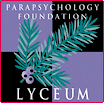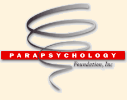 |
 |
| THE BIOGRAPHICAL DICTIONARY OF PARAPSYCHOLOGY GUSTAV PAGENSTECHER Physician. B. 1855, Germany; d. December 26, 1942, Mexico City. M.D., Leipzig University. Dr. Pagenstecher settled in Mexico shortly after receiving his degree in medicine and had been a practicing physician for forty years when by chance he discovered the apparent psychometric abilities of one of his patients, Mrs. Maria Reyes Zierold. Using hypnosis to treat her for insomina, he was astonished to find that while in trance she couls "see" beyond the closed doors of her room and that she acurately reported on persons and events outside normal vision. With the consent of Mrs. Zierold, Pagenstecher embarked on a series of experiments designed to test whether the blocking of her physical senses by hypnosis in some way stimulated her paranormal perception. He found that when, in response to hypnotic suggestion, she was impervious to the pain of needle thrusts, unresponsive to loud noises in her ears or to the sharp smell of ammonia, she would nevertheless report accurately sensations of vision, smell, taste, hearing and feeling received from objects unknown to her that were placed in her fingers. Although the purpose of the experiments was first thus to test her extrasensory perception, Dr. Pagenstrecher was further surprised to find Mrs. Zierold reporting details connected with the history or background of the objects she held. Risking his considerable reputation as a physician, Dr. Pagenstecher in 1919, a few months after he began his experiments, reported on them to the medical society of Mexico City, of which he was a member. He asked the society to appoint a committee to study Mrs. Zierold in trace. Several pumice stones were used in experiments with Mrs. Zierold before this committee. Although committee members could detect no odors or other distinguishing characteristics among the stones, they had been chemically treated. Mrs. Zierold described the lake from which four of the stones had come, reported strong odors from those that had been soaked in chemicals, received the sensation of heat from one that had been heated for a short time several days previously, sensations of cold from another that had been subjected to low temperature, and even noted "the tick-tock of a clock and the sound of church bells" when she held a stone that had earlier been placed for a period in the case of a stricking clock. The medical committee upheld Dr. Pagensteher's claims that the phenomena were of a supernormal nature. The physician reported his experiments to the American Society for Psychical Research ("A Notable Psychometrist," ASPR Journal, Vol. 14, 1920). In 1921 Dr. Walter Franklin Prince (q.v.) visited Mexico to observe experiments by Pagensteher with Mrs. Zierold and to conduct his own experiments with her. He found the physician's experiments admirably controlled, even to measures taken to prevent possible telepathic communication. Prince considered the results of his own experiments less spectacular than those achieved by Dr. Pagenstecher but nevertheless veridical, genuine and "quite inexplicable on a chance theory." See "Psychometric Experiments with Maria Reyes de Z. (W. F. Prince; ASPR Journal, Vol. 16, Jan. 1922); in the ASPR Proceedings, a longer version of the latter under the same title (Vol. 15, 1921); and "Past Events Seership" (Gustav Pagenstecher; ASPR Proceedings, Vol. 16, Jan. 1922). Dr. Pagenstecher also wrote the book Die Geheimnisse der Psychometric oder hellsehen in die Vergangenheit (Secrets of Psychometry or Clairvoyance into the Past; 1928). Taken from Helene Pleasants (1964) Biographical Dictionary of Parapsychology with Directory and Glossary 1946-1996 NY: Garrett Publications |
 |

|
 www. parapsychology. org |
||